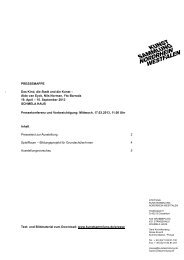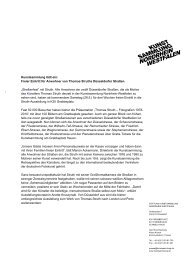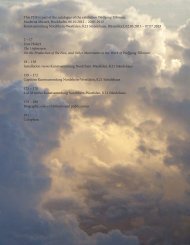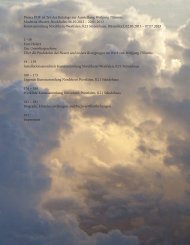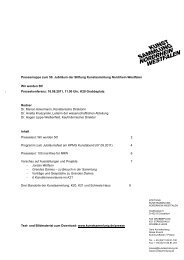Download online catalog (pdf)
Download online catalog (pdf)
Download online catalog (pdf)
You also want an ePaper? Increase the reach of your titles
YUMPU automatically turns print PDFs into web optimized ePapers that Google loves.
thought that classify and interpret them.’ 12<br />
In order to understand why the work of Wolfgang Tillmans – so seemingly casual, so<br />
heterogeneous and so wide-ranging – is not only extremely successful, but has, for over twenty<br />
years, been intelligible and influential both within and outside the field of art, with the result<br />
that by now his praxis seems like a universal, subtly normative style of perception and imagemaking,<br />
it is essential to consider the ‘conditions’ alluded to by Rancière. For these are fundamental<br />
to the specific visibility and speakability of this œuvre and to its legitimacy as art.<br />
In view of the task implied by Rancière’s concept of ‘conditions’, it is advisable to reflect<br />
not only on the artist and the relationalities of his work but also on one’s own position and<br />
relation as critic, art analyst, mediator, interlocutor, theorist and observer of this work. For<br />
how does one establish what might be called a relationship to artistic work – and how can this<br />
relationship be formed and changed? The most obvious way, in the context of a publication<br />
being produced to accompany a major overview exhibition, is to work one’s way through the<br />
categories associated with the work. The institutional configurations and infrastructures that<br />
connect the artist, the critic, the museum, the marketplace and the format ‘survey exhibition’<br />
determine questions as to the unity or heterogeneity of an artist’s production, for in this web of<br />
interconnections every exhibition, every publication, every text reproduces and reconstitutes<br />
the work.<br />
That I am writing, as the author of this essay, on the work of Wolfgang Tillmans, is the<br />
outcome of a whole series of material and epistemological circumstances. By that I am referring<br />
less to the anecdotal level of acquaintanceship and a partly shared history 13 than to the<br />
constantly startling (although, or maybe because, it is so natural) and disturbing fact that any<br />
encounter with an artist’s ‘work’ is also experienced (and is lived out) as an encounter with<br />
another person. The economy of the art market – with its dependence on originality, authorship<br />
and uniqueness– is structurally at the mercy of the signature of the individual artist. That<br />
this very singular market is so personalised goes back to all sorts of aesthetic, art historical and<br />
sociological manifestations of artistry, creativity and the artistic genius, all of which can be<br />
traced back to the early modern era; these were then taken to full effectivity by the nineteenthcentury<br />
bourgeoisie and, in our own time, culminated in the cult of the creative persona and<br />
his or her never-ending performances. The ongoing desire for a monographic view of a visual<br />
artist goes back to these precepts; at the same time it also pre-forms recipients’ attitudes and<br />
critics’ perspectives.<br />
The Production of the New<br />
Wolfgang Tillmans deals with this traditional mediation of the work and subject in a carefully<br />
considered, highly strategic manner. He knows that this mediation owes its existence to the<br />
historical development of the role of the author and as such is fundamentally open to criticism<br />
and to review; and he exploits the malleability of this principle by deliberately seeking<br />
out experiment and, hence, taking a calculated risk that the relationship of ‘indeterminacy’<br />
and ‘determinacy’ is not always that of the ‘moment’ to the ‘whole’, in the way that Theodor W.<br />
Adorno, for instance, still insists in his aesthetic theory. 14 The ‘unforeseen’ is one of Tillmans’<br />
guiding principles. As long as a thing cannot be planned and cannot be subsumed in discourse,<br />
12 Jacques Rancière, Aisthesis. Scènes du régime esthétique de l’art (Paris: Galilée, 2011), 10.<br />
13 In the late 1990s, for instance Wolfgang Tillmans and I, along with Jutta Koether and Diedrich Diederichsen<br />
were all actively involved in the publication of the German music and pop-culture magazine Spex, based in<br />
Cologne.<br />
14 See Theodor W. Adorno, Ästhetische Theorie (Gesammelte Schriften, vol. 7), (Frankfurt am Main: Suhrkamp,<br />
1970), 63f.



